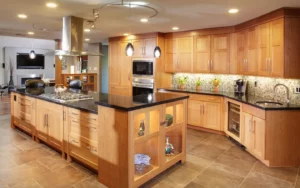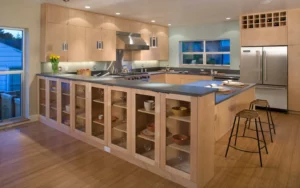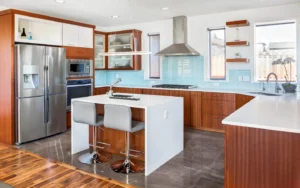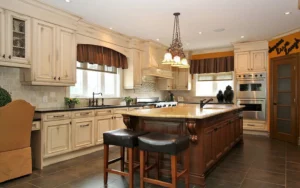High-end cabinets are premium-quality cabinetry designed and constructed using top-of-the-line materials and craftsmanship. These cabinets are known for their superior quality, aesthetic appeal, and durability.
High-end cabinets perfectly combine three key factors: quality materials, quality of workmanship, and unique styling. These elements distinguish high-end cabinets from their counterparts and contribute to their exceptional appeal.
Firstly, high-end cabinets are crafted using top-notch materials of the finest quality. These materials often include solid hardwoods like cherry, walnut, or oak or luxurious options like exotic woods like mahogany or teak. Using premium materials ensures durability, longevity, and a stunning visual aesthetic.

Secondly, high-end cabinets are the result of impeccable workmanship. Skilled craftsmen employ their expertise to construct these cabinets with precision and attention to detail. Every joint, corner, and surface reflects the highest standards of quality. Advanced construction techniques, such as solid wood joinery or intricate carving, showcase the mastery involved in creating these cabinets.
High-end cabinets exhibit unique styling that sets them apart. They feature innovative designs, distinctive detailing, and personalized touches that reflect individuality and craftsmanship. Whether it’s intricate moldings, custom hardware, or exclusive finishes, these cabinets embody a sense of exclusivity and sophistication.
High-end cabinets offer exceptional beauty, durability, and customization by combining quality materials, superior workmanship, and unique styling. However, it’s important to note that the cost of high-end cabinets can vary based on these factors, additional features, and brand reputation.
Read more about cabinet types
Characteristics of High-End Cabinets:
Quality Materials: One of the defining characteristics of high-end cabinets is the use of top-quality materials. These cabinets are crafted using premium-grade woods such as solid hardwoods like cherry, walnut, and oak or exotic woods like mahogany or teak. The selection of high-quality materials ensures durability, longevity, and a luxurious visual appeal for the cabinets.
Superior Craftsmanship
High-end cabinets are distinguished by their superior craftsmanship. Skilled artisans and craftsmen employ meticulous techniques to construct these cabinets with precision and attention to detail. They utilize advanced woodworking skills and joinery methods, such as dovetail or mortise-and-tenon joints, to ensure the cabinets’ strength and stability. The result is a product of exceptional quality and durability.
Impeccable Finishes
High-end cabinets feature impeccable finishes that enhance their appearance and protect the underlying wood. These finishes can include hand-applied stains, glazes, or lacquers, resulting in rich, deep colors and a smooth, lustrous surface. The finishes not only showcase the natural beauty of the wood but also provide an added layer of protection, ensuring that the cabinets retain their pristine condition over time.
Customization Options
High-end cabinets offer a high degree of customization, allowing homeowners to tailor the cabinets to their preferences and needs. This customization can include selecting the style and design of the cabinets, choosing from various finishes, hardware options, and additional features. The ability to customize the cabinets ensures that they seamlessly integrate into the overall design scheme of the space while catering to functional requirements.

Attention to Detail
High-end cabinets are characterized by meticulous attention to detail. Whether it’s intricate carvings, decorative moldings, or unique design elements, these cabinets showcase an elevated level of craftsmanship. Every aspect, from the edges to the corners, reflects a commitment to precision and excellence. The attention to detail enhances the overall aesthetic appeal and adds a touch of sophistication to the cabinets.
Durability and Longevity
High-end cabinets are built to withstand the test of time. High-quality materials, solid construction techniques, and superior finishes contribute to their durability and longevity. These cabinets are designed to withstand everyday use and maintain their beauty and functionality for years.
Exclusive and Luxurious Appeal: High-end cabinets exude an exclusive and luxurious appeal. Combining premium materials, superior craftsmanship, impeccable finishes, and attention to detail creates a sense of luxury and sophistication in any space. They become a focal point and elevate the overall aesthetic, enhancing the value and beauty of the surrounding environment.
In summary, high-end cabinets are characterized by their use of quality materials, superior craftsmanship, impeccable finishes, customization options, attention to detail, durability, and an exclusive and luxurious appeal. These characteristics collectively contribute to their exceptional quality and set them apart as premium cabinetry options.
Read more about modern home cabinets
Cost Considerations
Factors Affecting Cost: The cost of high-end cabinets can vary significantly based on several factors. These include:
Materials:
The choice of materials significantly impacts the cost of high-end cabinets. Exotic woods and premium hardwoods are more expensive than standard woods due to their rarity and quality.
Size and Complexity:
The size and complexity of the cabinets play a role in determining the cost. Larger cabinets or those with intricate designs, multiple compartments, and customized features will generally cost more due to the additional labor and materials involved.
Customization:
High-end cabinets often offer a high level of customization, allowing homeowners to select specific finishes, hardware, storage solutions, and other personalized features. The more extensive the customization, the higher the cost will be.

Additional Features:
Incorporating specialized storage solutions, integrated lighting, or high-end hardware can also increase the cost of the cabinets. These additional features contribute to the cabinets’ functionality and aesthetic appeal.
Brand Reputation:
The reputation of the brand or manufacturer can impact the cost of high-end cabinets. Well-established brands with a reputation for quality and craftsmanship often command higher prices.
Value and Investment
While high-end cabinets come with a higher price tag compared to standard cabinets, it’s important to consider the long-term value and investment they offer. High-end cabinets are built with superior materials, craftsmanship, and customization, ensuring durability and longevity. They also add significant aesthetic appeal and can enhance the value of your home. Investing in high-end cabinets is a long-term investment in your living space’s quality, functionality, and overall appeal.
When considering the cost of high-end cabinets, it’s essential to weigh the factors mentioned above against your budget, desired aesthetic, and the value you place on quality and customization. Working with experienced professionals and exploring different options will help you find the perfect balance between cost and the high-end cabinet solution that best meets your needs and preferences.
Types of High-End Cabinets:
Traditional Cabinets: Traditional high-end cabinets embody classic design elements and are known for their timeless elegance. They often feature raised or recessed panel doors, intricate moldings, and decorative hardware such as antique-inspired handles or knobs. Traditional cabinets can be further categorized into various styles, including:
European Traditional:
These cabinets draw inspiration from European design traditions, such as French or English country styles. They may exhibit ornate carvings, arched details, and elaborate moldings.

American Traditional:
These cabinets combine classic and colonial aesthetics with a touch of American design influence. They often feature rich wood finishes, paneling, and refined detailing.
Contemporary Cabinets:
Contemporary high-end cabinets embrace sleek, minimalist designs characterized by clean lines, simplicity, and a focus on functionality. They often feature flat or slab doors with minimal ornamentation, emphasizing smooth surfaces and geometric shapes. Contemporary cabinets can be further divided into:
Modern:
Modern cabinets prioritize simplicity, featuring clean lines, minimal hardware, and often a glossy or matte finish. They showcase a sleek and uncluttered look, often with a monochromatic color palette.
Scandinavian:
Inspired by Scandinavian design principles, these cabinets emphasize light and natural elements. They feature light-colored woods, minimalist handles, and open shelving, creating a sense of airiness and simplicity.

Transitional Cabinets:
Transitional high-end cabinets combine elements of both traditional and contemporary styles, resulting in a harmonious and balanced aesthetic. They offer a versatile option that suits a wide range of design preferences. Transitional cabinets typically feature clean lines with subtle detailing, blending traditional styles’ warmth and charm with the contemporary design’s simplicity and functionality.
Custom Cabinets:
Custom high-end cabinets provide the ultimate personalization and flexibility. They are built to order, tailored to specific requirements, and designed to fit seamlessly into the intended space. Custom cabinets allow homeowners to choose every aspect, including materials, finishes, hardware, storage solutions, and unique design features. This ensures a truly one-of-a-kind cabinetry solution that perfectly matches individual tastes and needs.
When considering the types of high-end cabinets, it’s essential to explore various brands, manufacturers, and designers, as they may offer their signature styles and interpretations of these categories. Ultimately, the choice of cabinet type will depend on personal preferences, the desired aesthetic, and how well it aligns with the overall design theme of the space.
KEYWORDS:
